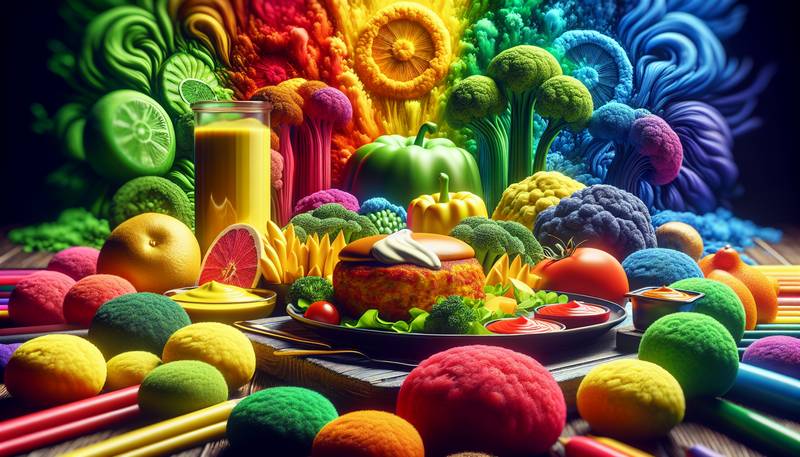Color Innovations in Plant-Based Meats: Enhancing Visual Appeal

The Color of FlavorSomewhere between the days of cavemen cooking over open flames and the time when “paleo” became a trendy diet, humanity discovered that food shouldn't just taste good, but look good too. Imagine coming home after a long day, ready to whip up a delicious meal, only to find a plateful of brown blobs staring back at you. It’s enough to send anyone running for the nearest pizza joint. Color is a crucial ingredient for excitement, and in the realm of plant-based meats, it’s becoming a focal point. Bright greens, sunny yellows, and fiery reds are no longer reserved for salad bars. Today, manufacturers are on a quest to ensure that their plant-based offerings are not just nutritious but visually enticing. After all, we eat with our eyes first—unless we’re eating nachos at 2 AM, in which case all bets are off.Why Color MattersIn the world of culinary delights, color signals freshness and quality. An attractive plate not only tempts the taste buds but also triggers memories of delicious meals past; it’s like the brain has its own little playlist of food nostalgia. In plant-based meats, color can also influence perception of flavor. A vibrant red might suggest a juicy, savory bite, while an earthy brown could promote thoughts of hearty and wholesome. For many consumers, the quest for a meat replacement isn’t just about avoiding animal products; it’s also about experiencing the joy of familiar textures and flavors. The wrong color might leave consumers feeling like they’ve been duped into a sad salad instead of a satisfying burger. New ingredients and natural colorants, such as beet juice and turmeric, are being harnessed to create visually appealing alternatives that are as inviting as they are nourishing.Ranch or Rainbow? The Color Palette of Plant-Based MeatsIf plant-based meats were a painting, they’d be a vibrant abstract piece, with splashes of color that evoke feelings of joy and hunger. Here are some innovations that have come to life in the color department:- Beets for the Bold: Beet juice, which gives burgers a rich red hue, makes plant-based patties look like their animal counterparts. Just like a well-written sitcom, they look good without even trying too hard.
- Turmeric Triumph: This spice from the East not only adds a sunny yellow to the mix but also a hint of earthiness. Maybe it’s time for turmeric to get its own star on the Hollywood Walk of Fame.
- Spinach Sensation: Thanks to the zest of spinach, some products boast vibrant greens that make you feel like you’re eating something healthy—even if you definitely aren’t.
- Charcoal Chic: The trendiest of plant-based meats features activated charcoal to produce a striking black appearance, perfect for the Instagram generation looking to wow their followers.
Most importantly, this healthcare-conscious crusade is about more than just aesthetics; it’s also about sustainability. These colorings frequently come from natural sources and can be part of a larger strategy to produce environmentally friendly food options.The Science Behind the ColorWhat makes a food colorful? It’s all in the pigments! From chlorophyll to carotenoids, the science of plant pigments is complex and fascinating. Exploring this realm requires not just a paintbrush, but also a lab coat—think of it as a delightful mix of art and science.Research indicates that color influences not only preferences but also nutritional perception. For instance, vibrant hues often correlate with higher levels of antioxidants, making that bright green patty more than just a pretty face. In the race to win over skeptical carnivores, ensuring that plant-based meats present their pigments proudly can make all the difference in shifting consumer preferences.Feeding the Eyes and the StomachNot all heroes wear capes; some come in the form of plant-based meat innovators wielding color charts and culinary creativity. They’re on a mission to make our plates pop, reminding us that food is an experience, not just a necessity.The path to consumer acceptance will likely hinge on creating visually appealing options that taste as good as they look. This endeavor doesn’t just enhance sales; it elevates the way we think about plant-based diets and sustainability.Color Me Satisfied!As the world evolves, so do our plates, redefining what it means to enjoy our meals. The innovation in the vibrant palettes of plant-based meats signifies a new era that is exciting both for our taste buds and the environment. Let’s raise a colorful toast to the future of food, where no meal should ever look like a sad, gray affair. After all, life is too short for dull dinners!
|
|







